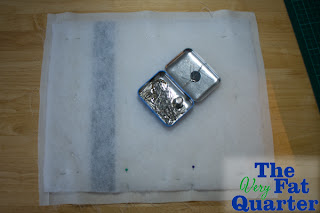11 1/2" x 14" Placemat Tops
11 1/2" x 14" Batting / Wadding / Thin foam
15 1/2" x 13" Backing
Rotary Cutter
Cutting Mat
Optional - AD505 Temporary Spray Adhesive
All your usual sewing tools
Step One
Make your placemat top. This can be pretty much anything you want. It can be patchwork, a single piece of fabric, or anything else you like. My tops are 11 1/2 inches x 14 inches, and include a 1/4 inch seam allowance.
Now, attach your batting to the top. You can use pins, but I use a temporary spray adhesive (AD505) which doesn't gum up the needle, and washes out without leaving any sticky residue. This step is optional, but, it gives the placemat a little more padding, and thus protects your table a little more.
Step Three
Cut your backing fabric. This can be anything you like - patchwork (then they can be reversible) or a single piece of fabric like mine. I cut mine quite a bit bigger than the front for this tutorial, to allow for lots of movement with the sewing later. If you're more confident, you can cut yours the same size as the topper. Just remember, its easier to trim some of the fabric away, than to panic if the fabric's moved.(I speak from experience!) I cut mine 15 1/2" x 13". That was probably a little too big, but I wanted to be sure it was going to still fit afterwards!
Step Four
Take your placemat top, and place it right side down ontop of the backing, and pin it to the backing. (The adhesive would not work here, as you need to turn it the right way around soon.)
When pinning the top use two pins to mark where you are going to leave a gap. This is where you're going to turn the mat right way round. Make sure you leave a gap a bit larger than the width of your hand.
Step Five
Now, sew a 1/4 inch all the way around your mat, except between the two pins marking the gap. I had the batting up, so that it didn't clog up my feed dogs. When you start at the pin marking the gap, backstitch a few stitches to reinforce the area. Then, when you come back to the pin marking the gap, backstitch a few stitches again.
Step Six
Trim away any excess backing and batting, aligning with the topper fabric. Be careful not to cut the stitches. Also, trim the corners away to reduce bulk when turning.
Step Seven
Reach in through the gap that you left, and grab hold of the topper and batting, and pull it through the gap. Poke out all the corners, but be careful not to push too hard, as you may push through the stitches. Do not use a seam ripper for this task, as it has a very sharp point. Something with a blunt point would be much better.
Step Eight
This is the point that most other tutorials tell you to hand stitch the gap closed. You can do this if you like. I however have too little time for hand sewing, so I simply press the mat (it will loose some of it's fluffiness), making sure that the edges of the gap are nicely aligned, then top stitch it 1/8" all the way around the mat. Since your seam is 1/4", the 1/8" topstitch will close the gap nicely. Tie up, trim and bury all the knots and tails.
Step Nine
Now you need to sew a few lines across the mat. This will stop the batting from falling apart, or separating from the top. You can use any type of quilting you like. I used straight lines as it was pretty simple and fitted in with my theme. I did not sew over the burgundy strip. I sewed a 1/8" either side of it, and then the straight lines stopped at that line. Now, tie off the tails, bury and trim them as normal. Give the mat a final press to set all the stitching and give it a nice professional look.
Step Ten
Step back, admire your gorgeous work, then make another three, or five, or as many placemats as you need. These are lovely to give as a gift, or to make for special occasions. You can match fabrics from tablecloths, other interior decor, or even use novelty fabric. Just make sure that any fabric you use, can be washed in the washing machine. Also, be aware of colours - white is not a good choice for an everyday mat, but can be used for a special occasion. Here, I've used a tea stained cotton fabric, and a strip of cotton fabric.
And that's all there is to it. If you have any questions, please feel free to ask.
__________________________________________________________


















No comments:
Post a Comment